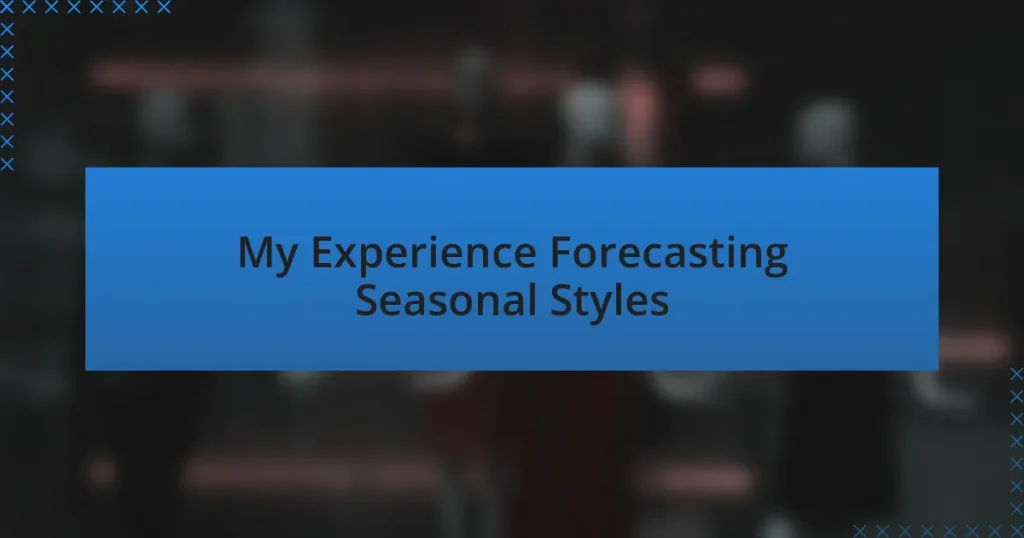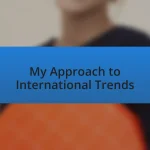Key takeaways:
- Seasonal styles reflect personal experiences and emotional connections, impacting wardrobe choices across seasons.
- Effective forecasting relies on trend analysis, consumer research, and engaging with industry events to understand upcoming styles.
- Challenges in forecasting include predicting audience preferences amidst fast fashion trends and balancing intuition with data-driven insights.
- Collaboration and adaptability are essential lessons, highlighting the value of diverse perspectives and responsiveness to shifting trends.
Author: Charlotte Hawthorne
Bio: Charlotte Hawthorne is an acclaimed author known for her compelling storytelling and richly drawn characters. With a passion for exploring the complexities of human relationships, her novels often blend elements of romance, intrigue, and self-discovery. A graduate of the University of California, Charlotte has received multiple awards for her work, including the prestigious Silver Quill Award. When she’s not writing, she enjoys hiking in the Sierra Nevada mountains and sipping coffee at local cafes. Charlotte currently resides in San Francisco with her rescue dog, Jasper.
Understanding Seasonal Styles
Seasonal styles are more than just trends; they’re like a reflection of our ever-changing environment. I vividly remember the thrill of swapping out my wardrobe as summer faded into fall, embracing the rich textures and warm colors that accompanied the cooler air. Isn’t it fascinating how each season brings an opportunity to express ourselves in different ways?
I often find myself excited about the return of cozy knits and stylish boots each winter. They not only keep me warm but also evoke those feelings of nostalgia—like hot cocoa by the fire and holiday gatherings. Have you ever noticed how certain styles can spark memories or emotions tied to a particular season?
Understanding seasonal styles goes beyond mere clothing; it’s about connection and identity. I love how a breezy sundress can lift my spirits during springtime, signaling new beginnings and adventures. What do you think makes a specific season resonate with you? I believe it’s those personal experiences that shape our relationship with fashion, making it an integral part of our lives.
Importance of Forecasting Styles
Forecasting styles is crucial for anyone deeply invested in fashion, as it helps in anticipating trends that align with changing consumer preferences. I fondly recall a season when the shift toward eco-friendly materials took the spotlight. Seeing retailers embracing sustainable practices made me feel like I was part of a larger movement toward positive change in the industry. Isn’t it empowering to know that our choices can influence what becomes popular?
Having a keen eye for what’s coming can mean the difference between staying ahead of the curve and being left behind. I remember attending fashion shows where certain colors and patterns emerged months before they hit the stores. It felt almost magical to witness those creations firsthand, like glimpsing the future of fashion in real time. Who wouldn’t want to be a step ahead, making savvy choices that they know will resonate with others?
The ability to forecast also fosters creativity. When I think about how I can weave anticipated trends into my unique style, it excites me. I often find joy in mixing older pieces with new arrivals, creating something distinctly mine. Isn’t it fascinating how our personal stories shape the way we interpret trends? Embracing forecasting styles isn’t just about fashion; it’s a journey of self-expression and innovation.
Methods for Forecasting Fashion
Fashion forecasting employs a variety of methods, each designed to glean insight into potential trends. One of my personal favorites is trend analysis, where I dive into social media platforms, observing what fashion influencers are wearing and discussing. I remember being captivated by a growing interest in vintage styles showcased in online posts—it was exhilarating to see how quickly a long-lost aesthetic could make a resurgence.
Another method I find invaluable is attending trade shows and fashion events. The energy at these gatherings is infectious, and you can feel the buzz surrounding emerging designers. I once stumbled upon a brand that showcased an unusual blend of textures, which I hadn’t seen before, yet it felt oddly familiar. Engaging with industry insiders and other fashion enthusiasts during such events helps me grasp not just trends but also the emotions driving those trends. Isn’t it intriguing how a single observation can spark countless ideas?
Finally, consumer research plays a pivotal role in my forecasting process. I make it a point to read reports and surveys that capture what shoppers are desiring or what issues they care about, like sustainability. Recently, I came across a study that emphasized a shift toward comfortable yet stylish loungewear during the pandemic. This resonated with my own experience as I too embraced that style shift. It raises a thought—how often do our insights align with broader societal changes? Understanding this connection can be the key to predicting what’s next in fashion.
My Approach to Seasonal Trends
When it comes to my approach to seasonal trends, I find that intuition often plays a significant role. I vividly recall walking through a bustling city street last fall, where the vibrant colors of changing leaves inspired me to embrace rich autumnal hues in my wardrobe. That moment made me realize how much nature influences what we wear; it felt almost like a gentle nudge towards adopting a specific palette that resonates with the season.
I also love experimenting with a mix of classic and contemporary pieces to see how they play out together. For instance, I paired an oversized plaid blazer—something I’ve cherished for years—with a modern graphic tee and high-waisted jeans. The resulting look was fresh yet grounded in nostalgia, sparking conversations everywhere I went. Have you ever felt the thrill of blending styles from different decades? It’s this kind of playful exploration that keeps my fashion choices dynamic and vibrant every season.
Furthermore, I pay attention to how seasonal changes affect our mood and lifestyle. When the days grow shorter, I notice myself gravitating toward cozy, layered outfits that not only keep me warm but also evoke a sense of comfort. Recently, I embraced knitted accessories, realizing how these small additions can elevate an outfit while nurturing that emotional connection to the chilly months. Isn’t it fascinating how the context of a season can shape not just our styles, but also our emotions and interactions?
Challenges in Forecasting Styles
Forecasting styles can often feel like trying to catch smoke with your bare hands. One major challenge I’ve faced is predicting which trends will resonate with people, especially in a world where influencers and social media dictate the pace. I remember confidently embracing a bold color trend last spring, only to find it fell flat when everyone gravitated towards softer pastels instead. How do you gauge what will truly captivate the audience? Sometimes, even the most intuitive forecasts can miss the mark.
Another hurdle is staying ahead of the curve amidst fast fashion cycles. The rapid turnover of designs can make it difficult to establish what’s timeless versus what’s fleeting. I recall a particular summer where I invested in a striking boho dress, only to watch similar styles flood the market within weeks. It’s disheartening when what feels unique quickly becomes ubiquitous. How do you strike a balance between personal style and the ever-changing trends? Navigating this landscape requires constant adaptation and a keen eye for what really matters.
Lastly, there’s the emotional aspect of forecasting styles—what resonates with the heart versus what’s dictated by numbers and analytics. I remember feeling a surge of nostalgia when a retro style resurfaced, sparking joy in a way that the data couldn’t quantify. It’s a reminder that fashion is not just about predictions but also about the stories and emotions we weave into our choices. Can data really capture the essence of what we love to wear? Personally, I find that blending intuition with market knowledge often yields the most authentic results.
Lessons Learned from My Experience
Looking back, one of the biggest lessons I learned is the importance of flexibility in forecasting. I had this vision of showcasing oversized silhouettes for fall, and just as I was ready to launch, cozy knitwear made a stunning comeback. I quickly pivoted, inspired by the warmth and comfort people craved. It taught me that when trends shift, being adaptable often saves the day.
Embracing collaboration with fellow fashion enthusiasts has also been invaluable. During one project, I partnered with a friend who had a completely different outlook on color palettes. Together, we discovered the beauty of blending unique perspectives. This experience reinforced that diverse insights can elevate forecasts beyond my individual style. Have you ever found that collaboration opens new doors for creativity?
Finally, I’ve realized that fashion forecasting is as much about understanding cultural nuances as it is about following trends. I recall attending a local festival where traditional patterns made a striking comeback, resonating deeply with attendees. This reinforced the idea that real style often draws from genuine cultural heritage. How often do we overlook the stories behind what we wear? By considering these influences, we can enrich our forecasts and connect more authentically with our audience.
Tips for Effective Style Forecasting
When forecasting seasonal styles, one of the most effective tips I’ve found is to immerse myself in the culture around me. During a recent trip to a vibrant art exhibit, I noticed how the installation’s color palette influenced the fashion choices of attendees. This moment taught me that trends are often born from artistic expressions. Have you ever seen how art can seep into your wardrobe? By embracing these cultural experiences, you can uncover fresh inspiration for your forecasts.
Another vital aspect is to keep an eye on social media trends but remain critical of them. I remember excitedly predicting pastel colors would dominate the summer, inspired by influencers and fashion weeks. However, as the season approached, I noticed people gravitated more towards bold, saturated hues instead. This realization reminded me that online trends can sometimes mislead. It’s worth asking yourself, how can you gauge whether a trend has real staying power or is just a fleeting moment?
Lastly, maintaining a consumer-centric perspective truly enhances forecasting accuracy. I once hosted a small focus group to test out seasonal styles, and it was enlightening to hear firsthand what styles resonated most with participants. Their preferences reshaped my forecast in unexpected ways, emphasizing the importance of listening to the consumer. Have you ever engaged your friends or peers for their fashion opinions? This kind of feedback loop not only refines your style predictions but fosters a deeper connection with your audience.


